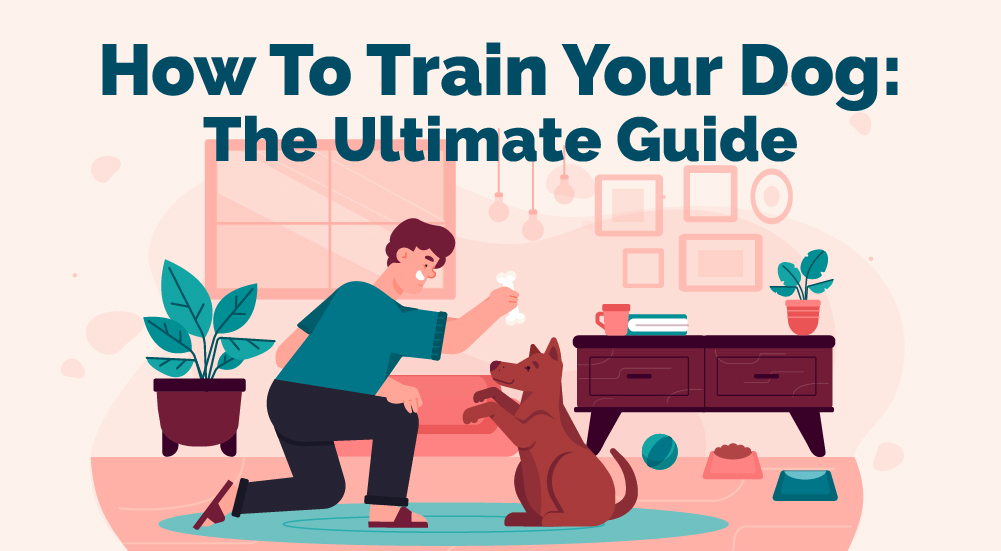Below, you’ll find step-by-step guidance on how to train your dog, several training commands, how to make sure they go to the bathroom in the right place, and how to make sure they behave when encountering other dogs on their daily exercise.
If you’ve recently welcomed a dog into your family, or you’ve been thinking about bringing a dog home for a while, there’s one thing that you need to know – training a dog is hard work.
It requires a lot of effort on your part and, regardless of how clever the breed is deemed to be, it will take a fair amount of time to get your canine-companion behaving well at home and when you take them a walk.
This doesn’t mean that it’s impossible, though!
To make things a little easier, and to help you and your dog develop a good training relationship, we’ve put together the ultimate guide on how to train your dog.
You’ll also find a ton of advice on why your dog is exhibiting certain behaviors, and how to rectify any issues before they become a bigger problem.
So, keep reading and pretty soon you’ll be well-equipped with all the information you need on how to train your dog.
Why it’s important to train your dog
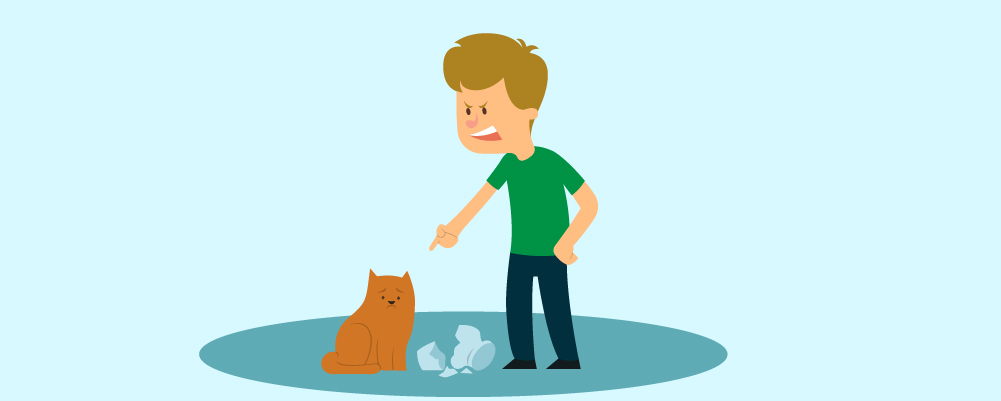
Let’s start by talking about why it’s important to train your dog. It doesn’t matter whether you’ve become the owner of a puppy that’s only several weeks old or you’ve rescued an older dog.
As soon as you meet your new furry friend, a hierarchy needs to be established. And, in that hierarchy, you need to be the boss!
If you don’t train your dog, you’re allowing bad behaviors to develop and go unchecked.
This can include urinating or defecating inside the house, excessive barking, and destructive behavior.
All of these issues can occur when your dog thinks they are the leader of the pack.
But, by establishing this hierarchy and showing them that you’re in charge, they will begin to understand their place, rather than thinking they are the alpha.
This doesn’t mean that your dog needs to fear you, though. In fact, it’s quite the opposite.
Good training will help you develop a strong bond with your dog and it will build trust and loyalty.
Through this, your dog will begin to look to you for guidance in certain situations rather than acting on their own instinct.
This bond needs to be established through encouragement and positive reinforcement.
No matter how frustrating you’re finding the process of training your dog, or how slowly your dog is learning, shouting at them or acting aggressively will not help you establish trust.
They’ll simply become scared of you, which is something that no dog owner wants. Training is also important for making sure your dog has a happy life.
It helps to reduce anxiety which, if left to develop, can lead to excessive barking or aggressive behavior.
This makes it much easier to leave them at home for a couple of hours when you need to, as well as reducing the chances of them exhibiting aggressive behavior towards other people or dogs when you take them out.
As we’ve said before, training is a journey that can take a while, and consistency is key.
If your dog has done something right or obeyed a command for the first time, you can’t expect them to remember to continue that behavior each time from then on.
You still need to keep training them until it becomes second nature. Of course, it can be all too easy to succumb to your dog’s cuteness and puppy-eyed gaze.
But you need to fight against this to train or even discipline your dog effectively.
You’ve got years of fun together ahead of you, and spending a few weeks teaching them certain skills and showing them who’s in charge will ensure your life together is a happy one.
What are the benefits of training your dog?
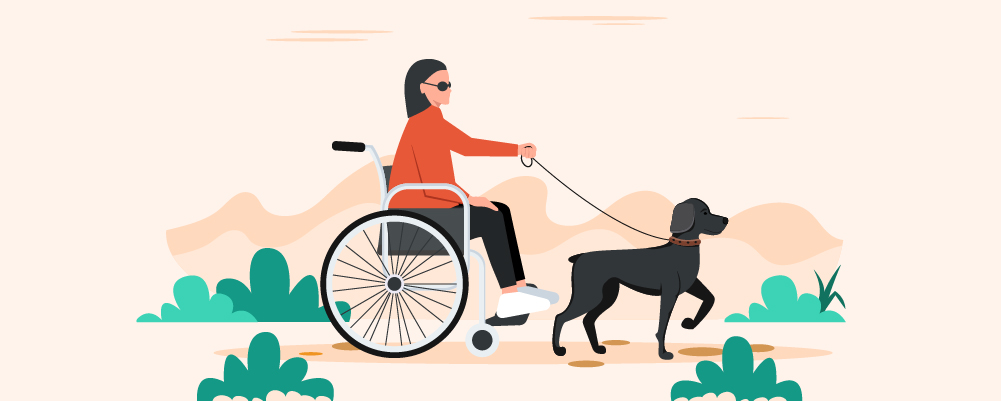
As we’ve discussed above, there are several benefits to train your dog. But it runs deeper than simply making sure that they behave at home and in public.
Good dog training will help your dog develop their intellect, satisfy their instincts in a well-behaved way, and build a foundation for more advanced training.
Below, we’ll take a look at some of the biggest benefits that come from training your dog.
Good Discipline: This is perhaps the most obvious reason for training your dog, but it’s an incredibly important one.
A well-mannered dog will be much easier to live with than a dog that is notoriously badly behaved!
A dog with good discipline will know where to go to the bathroom, won’t beg for food, and won’t start digging or scratching in areas that they shouldn’t be.
Put simply, they will know their limitations of what is acceptable and what isn’t.
Mutual Respect: The bond that you develop with your dog through training will ultimately lead to mutual respect.
This is hugely beneficial, as your dog will understand that you’re in charge without fearing you.
They’ll think of you as their best friend (and, undoubtedly, you’ll feel the same way about them), but they’ll look to you for guidance on how to react in certain situations.
They will also know their place in the family home, so there is much less of a chance that they’ll exhibit any aggression towards children, other family members, or anybody that you welcome into your home.
Satisfies Instincts: Dog’s have certain instincts that they need to satisfy. They need to run, play, and bark.
They also need to feel as though they have accomplished something with their day, much in the same way humans.
But these instincts all need to be satisfied in certain places and in a certain way. Good training can help with this.
Instead of your dog running around your home and creating havoc, they’ll know that the local park is the place to do this.
They’ll also know that they can bark a friendly “Hello” to their dog friends when they get there, rather than creating a noise disturbance in your home.
Develops Intellect: Dogs are thinkers and observers, just like we are. They are also among the most intelligent animals on the planet.
But, a dog that isn’t trained properly may use their brain-power to develop bad behavior.
Another benefit of training your dog properly is that it will develop their intellectual skills. It will help them learn and identify what’s right and wrong.
It will stop them from barking at strangers or other dogs, as well as teaching them how to learn and retain certain tricks.
Social Skills: Even though your dog will undoubtedly adore you, they still need to have some dog-friends with whom they can socialize.
There are loads of benefits that come from training your dog to be well behaved in a social setting.
They won’t be aggressive to other dogs, they won’t be afraid of new dogs they might encounter on their walk, and they will be able to communicate in their own language without any fear.
They’ll also be able to meet new people without being badly behaved, which is essential for taking them out into the public and when they meet your friends and family.
Happy Dog: One of the biggest benefits that you’ll get from training your dog is knowing that you’re building their confidence, feeding them the attention they crave, and generally making them much happier!
You’ll get satisfaction from this, too.
The happily wagging-tail and panting smile your dog will have painted across their face while they learn will bring you a lot of joy and will encourage you to continue with their training so they can develop their skills even further.
Advanced Training: Teaching your dog some basic training skills opens them up for more advanced training in the future.
This can include agility training, alpha training, or even training them as an assistance dog.
This is hugely beneficial for keeping your dog’s intellect well-exercised and making sure that they lead a happy, confident life.
How dogs learn

So, we know why it’s important to train your dog and the benefits that come from doing it correctly.
But how do dogs learn? Well, just like humans, there are several ways that dogs learn and develop new skills.
Instinctive
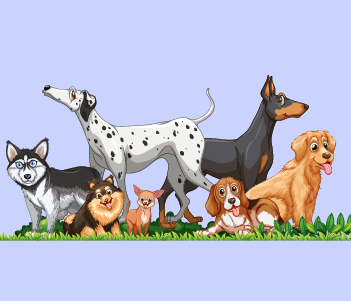 Humans and dogs have had a special relationship for thousands of years, and over these years different breeds have been tasked with performing certain jobs including guarding and herding.
Humans and dogs have had a special relationship for thousands of years, and over these years different breeds have been tasked with performing certain jobs including guarding and herding.
And, as time moved on, doing these jobs became instinct.
Removing a dog’s instincts isn’t something that any human is capable of.
However, you can manage their instincts through training using positive reinforcement to tell your dog what behavior is acceptable, and what behavior isn’t.
For instance, rewarding your dog for walking alongside you without pulling will teach them that their instinct to pull ahead isn’t acceptable.
Likewise, if your dog is barking excessively but getting no reward, they are more likely to stop as it doesn’t result in any praise or attention, and their instinct to do so will be reduced.
Adaptive
 Adaptive-learning refers to how a dog solves new problems, and the analytical skills they use to overcome them.
Adaptive-learning refers to how a dog solves new problems, and the analytical skills they use to overcome them.
You may have seen examples of this in YouTube videos, where a dog quickly figures out which button to press to release a treat.
The adaptive learning skills of a dog also go hand-in-hand with positive reinforcement.
They’ll think about how certain behaviors result in rewards, while others don’t, and they’ll quickly work out the right way of doing things.
Working and obedience
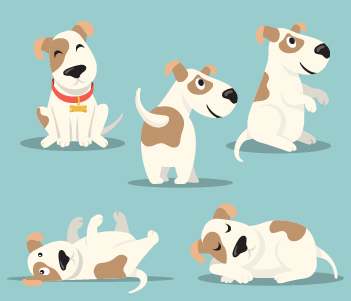 Teaching your dog commands and training them into good behaviors is essential, but the new skills they’ve learned need to stick in their memories too.
Teaching your dog commands and training them into good behaviors is essential, but the new skills they’ve learned need to stick in their memories too.
This is where their working and obedience intelligence comes in.
Again, positive reinforcement can be used here to help your dog retain information as well as making them eager to take direction from you.
How to housetrain your dog
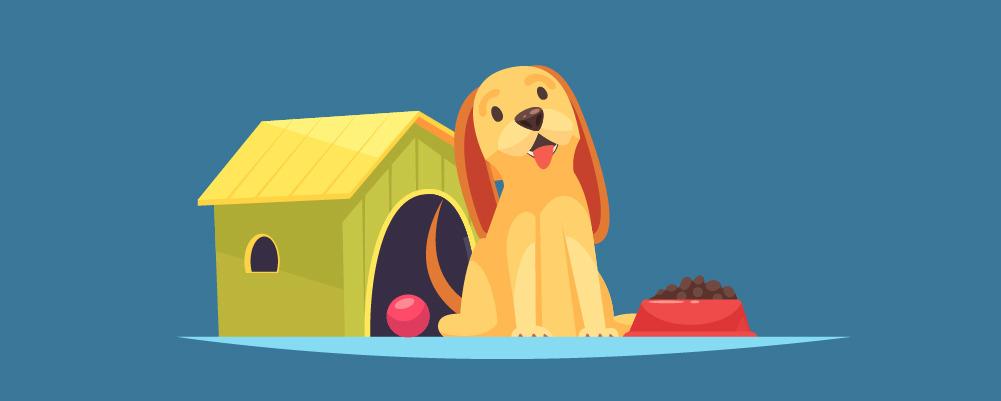
House training your dog is one of the most important things you need to do.
It doesn’t only ensure that they are going to the bathroom in the right place, but it also prevents them from urinating or defecating inside the house when you’re not home.
As with all dog training, however, it’s a process that takes time, patience, and commitment on your part.
Below, you’ll find some advice on how to housetrain your dog.
Help them learn where the correct place is to go to the bathroom and make sure they retain the information you’re teaching them.
Take your puppy outside frequently
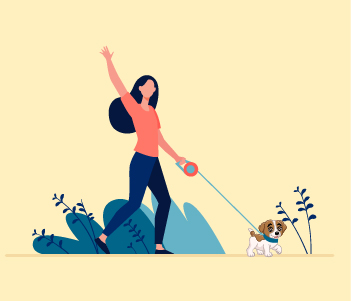 The first thing you need to make sure you’re doing is taking your puppy outside frequently.
The first thing you need to make sure you’re doing is taking your puppy outside frequently.
This presents them with the maximum number of opportunities to go to the bathroom in the right place.
There’s no use in getting frustrated with your puppy if they are having a few accidents indoors when the real cause of the problem has been that they’ve only been for one walk that day.
If you can, it’s a good idea to take your puppy outside once every hour throughout the day.
You don’t need to take them on a long walk, simply going for a short journey up and down your street is enough.
Or, if you have a garden or available outdoor space, put them on their leash and walk them around there.
Of course, this may not be a practical step for everybody as work, errands, and social engagements can take you away from home for a few hours at a time.
In this instance, you’ll need to make sure that you take your puppy for a walk before you leave the house, and as soon as you get back.
The house training process can be sped up a little by presenting as many opportunities as possible at times that your puppy will most likely need to go to the bathroom.
Wherever possible, take them outside at the following times:
- As soon as you wake up in the morning
- After each meal you’ve given them
- After playtime
- After naptime
Pick a bathroom spot outside
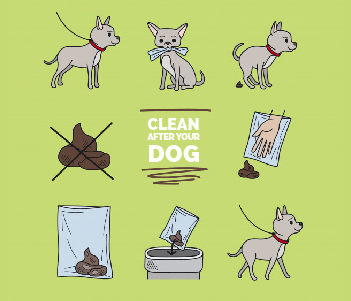 Repetition is key when your house training, which is the reason you’re taking them outside regularly.
Repetition is key when your house training, which is the reason you’re taking them outside regularly.
But, if at all possible, you should also make sure that you’re taking them to the same spot outside each time as well.
They will soon begin to associate this specific spot with going to the bathroom.
And, as they continue to add their scent to it, they will return to the same place every time.
There is another benefit to this, too.
If your dog visits the same bathroom spot every time, they are less likely to use your entire yard as a bathroom.
This makes it easier to clean up after them, as the mess will only be in one area.
It can also save your lawn from urine-burn, which leads to brown patches developing all over it.
You can also use puppy pads to teach your dog to go to the bathroom in one specific area of the house, such as the bathroom.
This is useful if you’re going to be away from your puppy for more than a couple of hours.
To do this the same house training process applies but, instead of taking them outside, you’re directing them to the puppy pad instead.
Reward them for going outside
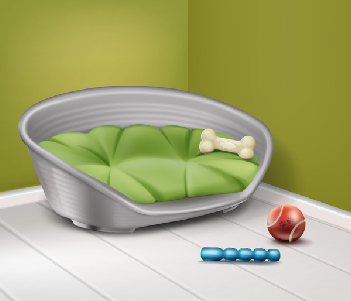 Positive reinforcement is essential when it comes to house training a puppy.
Positive reinforcement is essential when it comes to house training a puppy.
They need to know that they’ve done the right thing in the right place to repeat the process.
As soon as your puppy has finished doing their business outside, give them loads of praise and reward them with a small piece of their favorite treat.
They’ll soon begin to associate this attention and the tasty reward that comes with it as having done the correct thing, and they’ll be much more likely to repeat this behavior in the hope of being rewarded in the same way in the future.
You mustn’t begin praising them halfway through, though. If you do this, they may pause what they are doing and focus all of their attention on getting their reward.
This can lead to indoor accidents when they eventually remember what they need to finish doing.
It’s also important that you don’t let your puppy trick you into thinking they’ve gone to the bathroom in the right place!
Dogs are extremely clever animals after all, and if they can work out a way of getting a treat without having to do anything for it, they will!
So, keep an eye on them at all times and only reward them when they do go to the bathroom in the right place.
5 Essential commands to teach your dog
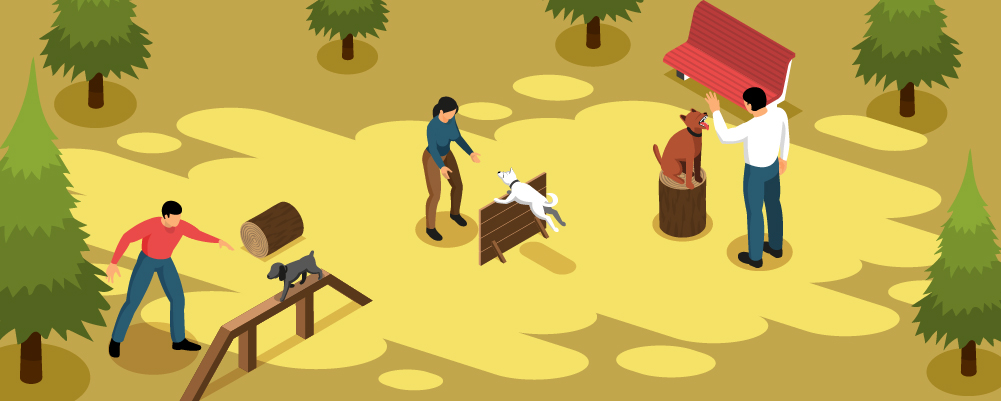
Once your puppy has completed their house training lessons and is consistently going to the bathroom in the right place, you need to move them onto their next set of lessons.
These are the 5 essential commands to teach your dog.
But why are they ‘essential’ commands?
Put simply, these go beyond basic tricks and are skills that could keep you and your dog safe when you’re at home and out in public.
Take the “Sit” command, for example.
Teaching your dog to obey this command while you’re waiting to cross the road will ensure that they don’t prematurely walk ahead, which could result in them getting seriously injured.
The same goes for the “Leave it” command.
Perhaps your dog is sniffing around something that you would rather they left alone, or they are in a silly mood and have gotten hold of something that they shouldn’t have.
Teaching them to leave it alone can help to keep them safe.
It’s important not to bombard your dog with too much information at once, though. As clever as they are, it’s usually a good idea to let them fully understand one command at a time.
Once you’ve completed one command, move on to the next, and so on.
Sit
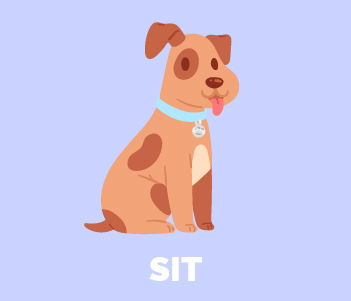 This is one of the most basic commands that your dog needs to learn and, luckily, it’s pretty easy to teach.
This is one of the most basic commands that your dog needs to learn and, luckily, it’s pretty easy to teach.
- Take a training treat and show it to your dog.
- Hold it above your dog’s nose (not too high, otherwise they may jump) and slowly move it back towards their ears, keeping it close to their head the whole time.
- When you do this, your dog will naturally adopt the sitting position when the treat reaches a certain point.
- As soon as they are sitting, hold the treat in place for a second or two, then give them loads of praise and reward them with the treat.
- Next, you need to repeat the same process but add in the cue word of “Sit” once your dog is in the sitting position.
- Gradually phase out the process of running the treat along their head. Instead, use the command word and, once they are sitting, reward them with the treat.
As with all dog training, practice makes perfect and it may take a couple of days for your dog to fully learn the “Sit” command.
Put some time aside each day to continue practicing and they’ll soon pick it up.
You also need to continue to practice the “Sit” command once they have mastered it, to keep it fresh in their memory.
Use it when you’re giving them their food, offering them a dental chew, or when you’re putting them on their leash.
Come
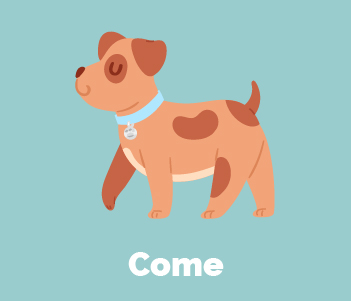 The “Come” command teaches your dog recall, and it’s an essential part of their training for showing them that you’re in charge.
The “Come” command teaches your dog recall, and it’s an essential part of their training for showing them that you’re in charge.
It’s also really important for bringing them back to you when they are off-leash.
- Start by taking your dog to an outside space that is still enclosed. Your garden is a good place for this, otherwise, a park that is surrounded by a reliable boundary is a great alternative.
- Try to filter out as many distractions as possible. If you’re in a public space and there are a lot of people or other dogs around, wait for things to quiet down before you start your lesson.
- Take your dog’s favorite toy with you and, before you let them off the leash, show it to them so they know it’s there and they are excited to see it.
- While showing them their toy, clearly say “Come” in an excited tone.
- You can now let your dog off its leash. They’ll soon start exploring, and as soon as they are a couple of meters away from you, use the “Come” command along with making sure the toy is visible.
- As soon as they come back to you, lavish them with praise and let them play with their toy for a minute before taking it off them and repeating the process.
If your dog bolts during one of these training sessions, it’s really important that you don’t chase after them.
This can confuse them and they’ll think it’s a game where you’re both running towards the same target. Instead, call your dog’s name and run in the opposite direction.
Since you’re the leader of the pack, they will likely start running after you instead. Once they’ve reached you, give them loads of praise.
It’s also important to know that it does take some breeds longer to learn the “Come” command than others.
Some are far more inquisitive and stubborn, while others are much more responsive.
Again, take the time to teach your dog this command over a few weeks, and continue to use it once they have learned it.
Down
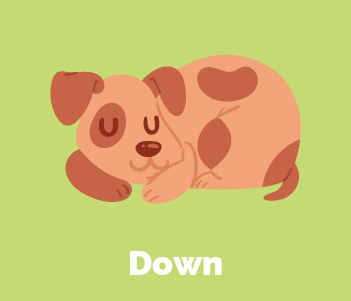 Teaching your dog the “Down” command is essential in a variety of situations.
Teaching your dog the “Down” command is essential in a variety of situations.
It stops them from getting over-excited when young children are around, it makes sure that they are well-behaved on public transport, and it can be used to keep them out of the way when you’re inviting somebody into your home.
- Using the “Sit” command, place your dog into a sitting position.
- Take your dog’s favorite treat and hold it about an inch in front of their nose.
- Slowly move the treat towards the floor. Your dog will follow it with their nose the entire way and, as with the “Sit” command, they will naturally fall into a lying position.
- As soon as their belly hits the ground and their front legs are directly out in front of them, give your dog loads of praise and reward them with the treat.
- Repeat the process and, while lowering the treat towards the ground, use the “Down” command.
- After a while, you can stop lowering the treat downwards and just show it to your dog instead. Use the “Down” cue and they will lay on the ground. Reward them with the treat, and continue practicing until they have mastered the command.
Use this command daily while training once they have learned it. This will help your dog retain the information and obey the command when you need them to.
Stay
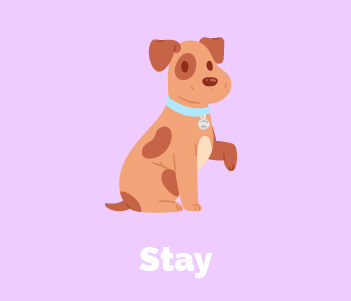 The “Stay” command is needed when you’ve called your dog back over to you using the “Come” command.
The “Stay” command is needed when you’ve called your dog back over to you using the “Come” command.
It’s also a good way of keeping your dog still while you’re putting on their leash, and for keeping them close to you in a potentially dangerous situation.
- Place your dog into a sitting position using the “Sit” command, then put their collar and leash on them.
- With your dog still sitting, say in a clear, firm voice “Stay” while holding one hand upwards in front of you in a ‘stop’ gesture.
- If your dog stays put, reward them with a treat.
- You now need to follow the “Stay” command with a cue that lets them know it’s safe to move on, such as “OK”, or “Walk”. Go for a few steps, then say “Stay” again while returning your hand to the stop-gesture. If they stay in place, offer them a reward.
Practice this over a few days, and then try removing their leash and using the command. When they are sitting, take a few steps backward, pause, and then offer them the reward.
Gradually increase the number of steps you take away from them until you’re a couple of meters away.
Leave it
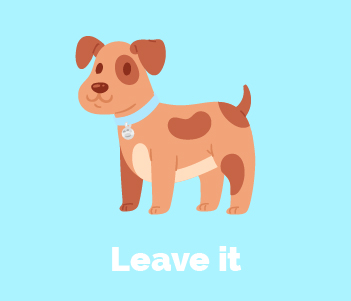 This is a command you’ll definitely need if you’ve got a super-inquisitive puppy, but it’s also a useful command for keeping your dog safe throughout its life.
This is a command you’ll definitely need if you’ve got a super-inquisitive puppy, but it’s also a useful command for keeping your dog safe throughout its life.
- Take your dog to a familiar environment with minimal distractions. A room inside your home that they are used to visiting would be a good choice.
- Place a training treat in one hand, and a super-special treat in the other. Put your dog into the sitting position, and sit down in front of them.
- Hold out the hand containing the training treat with your palm open and extended. As soon as your dog lurches forward to eat it, quickly close your palm and withdraw your hand while firmly saying “Leave it”.
- Next, expose the training treat to your dog again, but say “Leave it” while it’s visible to them. If they stay in place without attempting to eat it for 3 seconds, give them loads of praise and offer them the special treat instead. If they do attempt to eat the training treat, retract your hand, issue the command, and repeat the steps until they do leave it.
It won’t take long for your dog to realize that if they leave the training treat, they’ll be rewarded with something better.
They’ll also begin to associate the “Leave it” command with something better so, in a real-world situation, they’ll move away from whatever it is you want them to leave in the hope of finding something more exciting.
How to stop your dog from barking
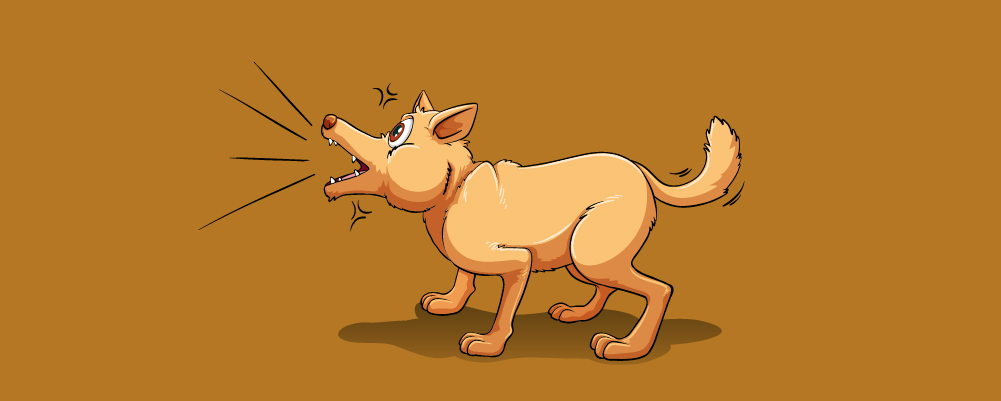
All dogs bark. It’s how they show their emotions and alert you to potential dangers.
However, excessive barking is something that needs to be dealt with swiftly.
If left to continue, it results in disruptive behavior both at home and when you’re out in public.
Below, we’ll talk about how to stop your dog from barking excessively.
The steps are all really simple and manageable, however, as with all dog training, it requires some patience and practice.
Remove the motivation
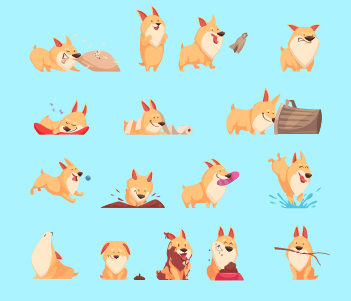 The main reason why your dog is excessively barking is that something motivates them to do it.
The main reason why your dog is excessively barking is that something motivates them to do it.
It’s simply their primal instinct kicking in and, as we’ve discussed above, you can’t remove a dog’s instinct.
You can, however, dilute it.
By removing the motivating factor in your dog’s barking, you’re increasing the chances of getting them to stop.
So, if your dog sits in a window and barks at any person that passes by, you can remove the motivation by closing the curtains or rearranging your living room furniture so that your dog isn’t able to get to a viewpoint.
Likewise, if your dog decides to excessively bark at any ambient sounds they hear when they’re out in your yard, bring your dog back into the house.
They’ll soon learn that excessive barking results in them being removed from their favorite place.
Ignore the Barking
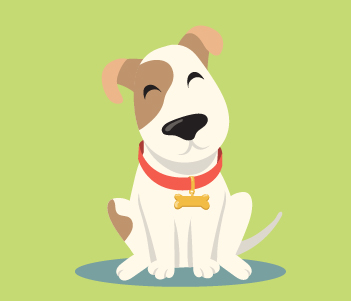 It does not always sound or the threat of an intruder that makes your dog want to excessively bark, though.
It does not always sound or the threat of an intruder that makes your dog want to excessively bark, though.
Sometimes it’s simply the demand for attention.
It’s extremely tempting to give in to this as you’ll undoubtedly want the barking to stop as soon as possible, however, giving them the attention they crave will simply lead to further excessive barking.
So, if you believe that your dog is barking for attention, you’ll need to learn to ignore it.
This isn’t an easy task, but it’s one to persevere with if you want the best results. Luckily, it’s a really simple training process. Here’s what you need to do:
- Once your dog starts barking, simply ignore them. Don’t look at them or touch them and, if they are in another room, stay where you are.
- As soon as they stop barking, reward them with a treat.
Again, patience is key here. Your dog may bark for a full hour before they finally realize that it’s not going to get them any sort of reward.
If you give in before they stop barking, you’ll only be rewarding them for bad behavior.
Desensitize them to the stimulus
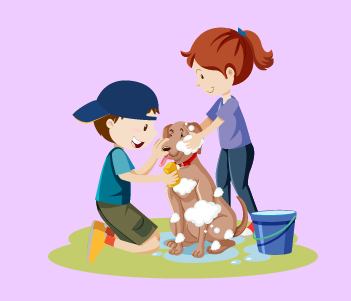 Perhaps you’ve noticed that your dog only barks at certain things. This could be bicycles, pigeons, or people wearing hats.
Perhaps you’ve noticed that your dog only barks at certain things. This could be bicycles, pigeons, or people wearing hats.
There may even be multiple triggers that are causing the excessive barking.
The best way of dealing with this is to desensitize them to the stimulus.
When you’re out on a walk, keep your dog on a short leash and purposefully head to an area that you know you’ll find the stimulus for your dog’s barking.
Then, follow these steps:
- Distract your dog by offering them a few treats, while slowly heading towards the stimulus.
- Once you’re a few feet away from it, keep your dog distracted with treats.
- As soon as the stimulus has gone, stop giving your dog treats.
- Keep an eye out for upcoming encounters of the stimulus, and repeat the process once you’ve spotted one.
The reason for doing this is that you want your dog to believe that being near the stimulus results in a reward, rather than thinking of it as something to be frightened of.
Keep your dog well exercised
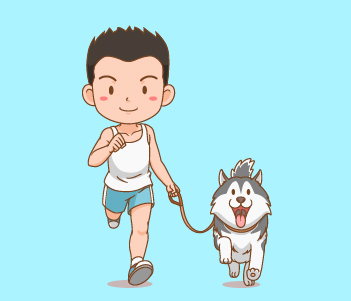 A tired dog has less of a need to bark excessively as they’ll simply be too physically and mentally exhausted.
A tired dog has less of a need to bark excessively as they’ll simply be too physically and mentally exhausted.
So, make sure that your dog is getting plenty of exercise every day and you’ll notice that they spend more time sleeping than they do barking!
The amount of exercise your dog needs will depend on its breed, age, and health.
Some will require several long walks and a good run around, while others will only need a one-hour walk once a day.
You know your dog’s limits better than anyone, however, to make things a little easier, we’ve put together a quick-reference guide to show you how much daily exercise your dog needs.
| Dog Group | Minutes of Exercise per Day |
| Brachy | 30 minutes |
| Sight Hounds | 45 minutes |
| Giant | 45 minutes |
| Toy / Small | 60 minutes |
| Terriers | 90 minutes |
| Scent Hounds | 90 minutes |
| Working | 120 minutes |
| Sporting | 120 minutes |
| Herding | 120 minutes |
Try and switch up your dog’s exercise routine to keep things interesting for them throughout the week, too.
Some days can be simple walks, while others could be a jog followed by a game of fetch.
You might also want to consider employing the services of a dog walker who can take your dog out for you when you’re at work.
Why does my dog chew things excessively?

If your dog is exhibiting destructive behavior by excessively chewing their toys or, worse, your furniture, there may be a bigger issue to deal with.
Below, we’ll take a look at the two main reasons why dogs chew excessively.
Learning the motivation behind this chewing can help you stop this behavior and prevent it from happening in the future.
Separation anxiety
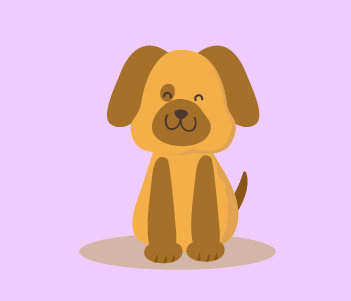 Separation anxiety is one of the most common causes of excessive chewing.
Separation anxiety is one of the most common causes of excessive chewing.
If you’re unsure what ‘separation anxiety means, it refers to certain behaviors that your dog exhibits when they are left alone.
Separation anxiety can cause your dog to feel stressed or nervous, and these feelings are often channeled into compulsive or destructive behavior.
The best way to help your dog overcome their separation anxiety is to teach them that being on their own at home is a good thing.
Save one special toy that they love as a reward when you leave the house.
You can also get treat-puzzles that help keep your dog occupied while you’re away and, once distracted, they may not even notice that you’ve gone!
Lack of stimulation/exercise
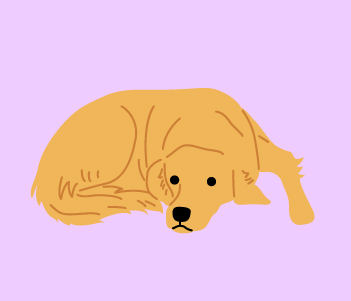
As with excessive barking, not getting enough exercise or stimulation throughout the day can also lead to chewing.
If your dog is mentally and physically tired, they’ll be far more likely to use their extra time to go to sleep, rather than seeing it as an opportunity to chew everything in sight!
How to stop your dog from chewing things

So, we know what causes a dog to chew excessively. But how can you stop your dog from chewing things in the future?
Below, we’ll go through some tips on how to dog-proof your home so that it’s much harder for them to chew on things.
This is especially useful if you’ve exercised your dog or given them a distracting toy, and they are still exhibiting this destructive behavior.
Normal Chewing Behaviour
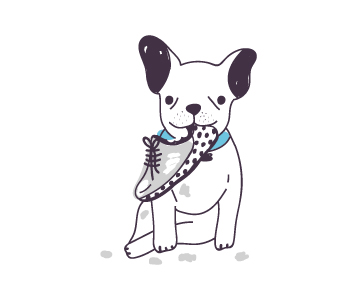 Before we look at dog-proofing your home, it’s important to take a moment to talk about normal chewing behavior.
Before we look at dog-proofing your home, it’s important to take a moment to talk about normal chewing behavior.
Just like humans, dogs have their own hobbies and interests, and chewing is a great way for a dog to spend some downtime.
You just need to make sure you’ve provided your dog with something suitable to chew on.
There’s a reason why there are so many chew toys available for dogs, after all.
Chewing is also a part of a puppy’s teething process. Just like children, puppies lose their first set of teeth and these are replaced by their adult teeth.
Chewing on something helps them to relieve the pain.
Dog Proof Your Home
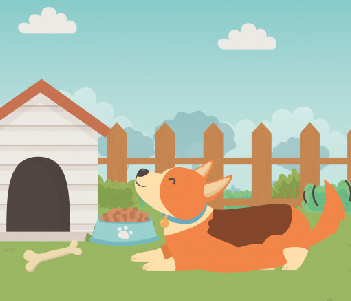 Dog-proofing your home is an essential part of being a responsible dog owner, particularly if you’ve recently become a parent to an inquisitive puppy!
Dog-proofing your home is an essential part of being a responsible dog owner, particularly if you’ve recently become a parent to an inquisitive puppy!
Dog-proofing doesn’t only keep your home safe from the bite marks brought on by destructive chewing, but it can also keep your dog safe.
Dogs don’t understand the dangers posed by certain household items and, if left to get into them, it could result in potentially fatal consequences.
Below, we’ll look at five ways that you can dog-proof your home to keep your canine companion and your belongings safe.
- Baby-Proofing: There are loads of baby-proofing accessories that are designed to stop children from getting in harm’s way. These are effective at keeping your dog safe, too. Baby gates can limit the number of rooms your dog is allowed in, while power-strip covers prevent your dog from chewing through power cords. You can also install safety locks on your kitchen and bathroom cabinets to stop particularly curious dogs from opening them!
- Pull-Out Trash Can: Your kitchen trash can will be full of irresistible smells to your dog, and the last thing you want to deal with is cleaning up slimy garbage that’s been pulled all over your floor. To stop your dog from getting into your kitchen waste, purchase a pull-out trash can. This allows you to keep it safely locked away inside a cupboard and out of your dog’s reach.
- Keep Doors Closed: If you’re not keen on the idea of installing baby gates all over your home, you can limit your dog’s access to certain rooms simply by keeping your doors closed. This is a really good idea when you’re house training too, as you’ll be able to keep a closer eye on your puppy and can take them straight outside when they are showing signs of needing to go to the bathroom.
- Tidy Up: Keeping your home tidy and clutter-free is a good way of removing temptation. If nothing is laying around to chew apart from your dog’s toys, their focus will be on those rather than any of your belongings.
- Crate: Keeping your dog in a crate is a good way to keep your home from being destroyed when you’re out of the house. It may seem cruel, but dogs can actually find comfort in their crates, seeing them as their own personal space that only they are allowed in.
Socializing your dog
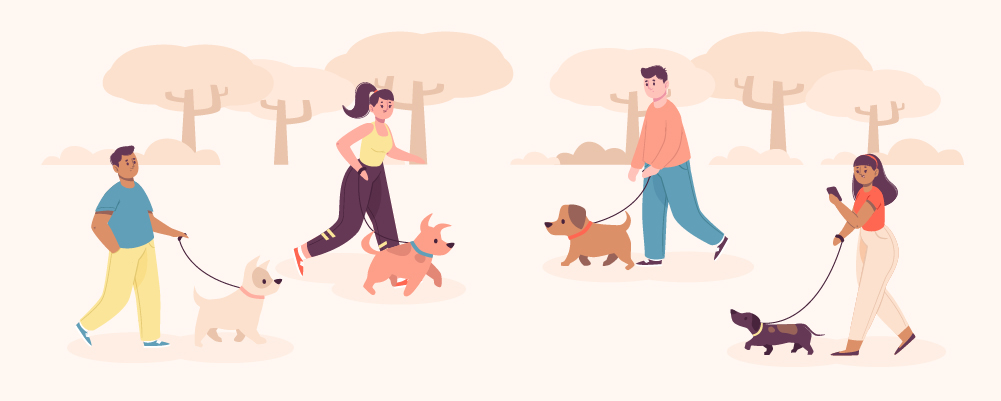
To train your dog to go to the bathroom and to follow commands is only one part of the dog training process.
Your dog also needs to be well socialized to exist in a busy world.
They need to be introduced to new people, children, other dogs, and shown all the sights and sounds that the big wide world has to offer.
Why is it so important?
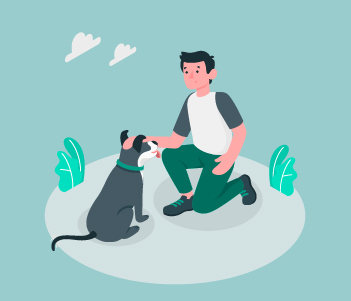 Dogs are social creatures, so keeping your dog away from other people and not letting them interact with other dogs will lead to significant behavioral problems.
Dogs are social creatures, so keeping your dog away from other people and not letting them interact with other dogs will lead to significant behavioral problems.
This includes aggressive behavior which, if allowed to develop, can be extremely problematic.
By introducing your dog to different people, animals, and social environments, they will feel much safer and less likely to exhibit disruptive behavior.
Socializing your dog is also important for teaching your dog how to get along with any other pets you might bring into your home, as well as those that belong to family and friends.
A well-socialized dog will also be much calmer when you take them to a veterinarian, as they’ll be used to meeting and being handled by new people.
Adults
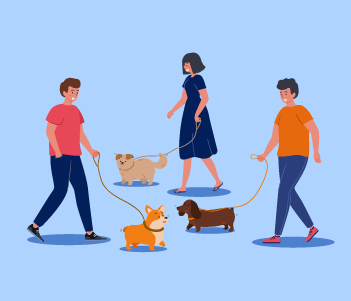 Whether you’ve got a puppy or an older dog, introducing them to other adults should be one of the highest priorities on your social training list.
Whether you’ve got a puppy or an older dog, introducing them to other adults should be one of the highest priorities on your social training list.
The more people your dog meets, the calmer they will be in social situations and the less aggressive they will be towards strangers.
The best way of doing this is to take your dog with you everywhere you go.
This includes visiting friends and family, walks through a busy city center, and anywhere else that you’ll come into contact with other adults.
The urge to stop and pet your dog will be irresistible to most people, and you should allow this to happen as it will teach your dog that other adults aren’t a threat.
Children
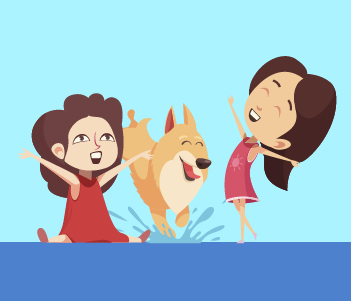 Introducing your dog to children is also important. Children tend to be louder and more energetic than adults and, if your dog has never encountered this, they may consider them a threat.
Introducing your dog to children is also important. Children tend to be louder and more energetic than adults and, if your dog has never encountered this, they may consider them a threat.
If you’re in a household with children, this is an easy thing to manage.
Ask your children to act calmly around your dog while they settle in and, when the dog is feeling playful, your children can be as loud as they like as your dog will think it’s all part of the fun.
If you don’t live in a household with children, it’s a good idea to try and introduce your dog to children of all ages as soon as possible.
Call on nephews, nieces, and friends’ children. Again, ask them to play calmly around your dog before increasing their energy levels.
Other dogs
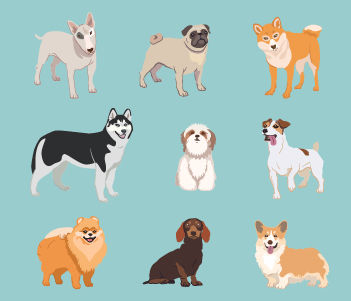 Finally, introducing your dog to other dogs is an important part of their socialization training. This needs to include a variety of breeds and ages.
Finally, introducing your dog to other dogs is an important part of their socialization training. This needs to include a variety of breeds and ages.
Start by keeping your dog on their leash as letting them sniff and interact with the other dog using their own language and social behaviors.
Once they have become acquainted with each other, let them off the leash and keep a close eye on them as they play.
They will most likely just round around and chase each other, but if anything becomes too boisterous you’ll need to intervene using the “Come” command.
Don’t jump the gun too soon, though! Dog playing can look aggressive, but it’s just how they play.
If you’re unsure if things are becoming aggressive, here are some body language signs to look out for that will show you they are actually playing:
- The ‘Bow’ Position: If your dog’s front legs are on the ground and they’ve got their rear in the air in a bowing position, they’re playing. Some dogs may even pound the ground with their front legs intermittently to show they’re ready to play!
- Playing Tag: When two dogs are running around, they may suddenly switch directions and the chaser becomes the one getting chased. This is their way of playing tag.
- Smiling: Dogs have really expressive faces and you can tell if a dog is having a good time simply by looking at the smile on their face! This won’t be there if they are feeling threatened by the other dog.
- Play Biting: Biting can seem like an aggressive thing when two dogs are playing, but it’s actually just a way of interacting with each other. If one dog is laying on its back, the other may give them some gentle nips on the nose or mouth. Both dogs may also bear their teeth but, as long as there isn’t any whimpering or growling, they are simply having a good time!
Summary
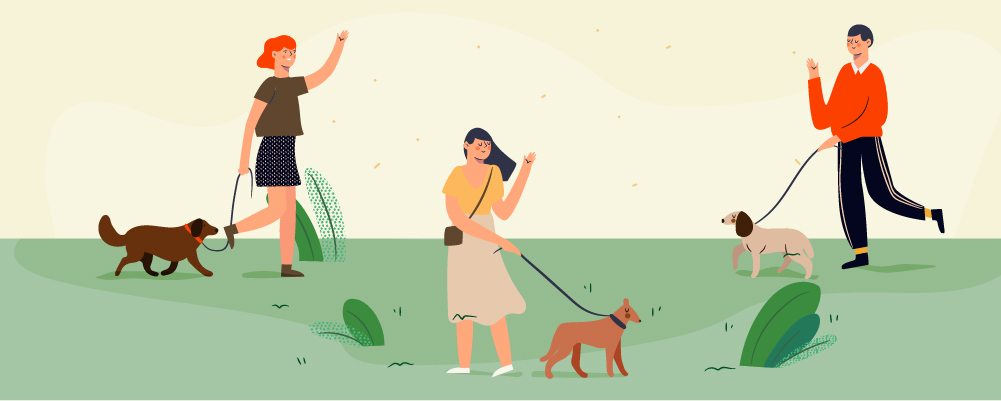
Whether you’re a brand new dog owner or have had a canine companion in the past, one thing is for certain – each dog is different and some breeds will take longer to train than others.
It’s all about perseverance.
Stick with the advice that we’ve outlined above, and you’ll have a happy, well-adjusted dog that is the model of good behavior!

